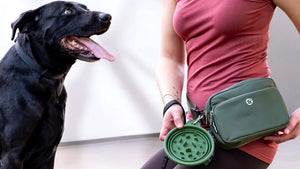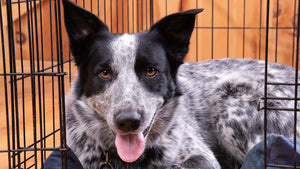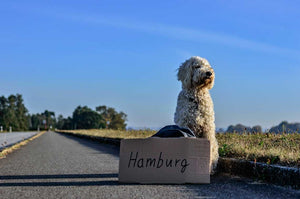Your Cart is Empty
💗FREE shipping on Oprah's Favorite Dog Walking Bag! Everything ships FREE on orders over $30 💗
💗FREE shipping on Oprah's Favorite Dog Walking Bag! Everything ships FREE on orders over $30 💗
💗FREE shipping on Oprah's Favorite Dog Walking Bag! Everything ships FREE on orders over $30 💗
💗FREE shipping on Oprah's Favorite Dog Walking Bag! Everything ships FREE on orders over $30 💗
Add description, images, menus and links to your mega menu
A column with no settings can be used as a spacer
Link to your collections, sales and even external links
Add up to five columns
Add description, images, menus and links to your mega menu
A column with no settings can be used as a spacer
Link to your collections, sales and even external links
Add up to five columns
April 23, 2025 6 min read
If you are a parent to a young, beloved puppy, this has probably happened to you once or twice: you are playing with your pup when all of a sudden, they give your hand a nip. Puppy biting can be annoying but fortunately, it’s relatively normal. Most puppies develop a chewing habit at some point, but it’s important to make sure the cute habit doesn’t grow into a problem. In this article, we’re going to tell you all about how to stop your puppy from biting.
Puppy biting normally begins three to four weeks after the puppy's baby teeth start to come in. In this period, your pup will likely want to bite, nip, chew, or gnaw anything that comes their way. And on their list of “things I love to bite,” your hand or fingers may just be somewhere in the top 5.
Some situations may encourage your puppy to bite. Common instigators of biting include:
When your puppy is young and teething, biting and chewing are a normal part of development. However, it can easily become a bad habit that you need to nip in the bud before it escalates to adulthood.
Here are our top tips for how to stop a puppy from nipping, gnawing, or chewing on humans or property:
Teaching a new command helps divert attention from biting behavior. Great commands to teach your dog include 'sit', 'lay down', 'heel', or 'stop'. Sit and stop are great commands to start teaching your puppy. Stop might be especially helpful for biting, as it’s exactly what you want them to do!
First, anticipate when your puppy may be tempted to bite you. A good opportunity is when they are overly excited and running to you to say hi. If they reach for your hand or ankle, gently grab their collar by the side and hold onto it.
To protect yourself from a side bite, ensure your palm rests on your dog’s cheek as you firmly hold onto their collar. Repeat the word ‘Stop’ as you hold their collar. What you are doing is holding your dog still while also allowing them to calm down completely.
It is okay if this technique does not work right away. Some puppies may lunge at your arm immediately after you let go. If you notice this, hold onto their collar even more firmly. For a stronger puppy, you might even want to use your other hand to press their entire body to your side until they are completely calm.
An alternative to ‘Stop’ is ‘Sit’, which we will cover next.
Once your puppy obeys a command don’t leave them hanging! It’s important for them to know they did well by rewarding their good behavior. This is where treats come in.
Immediately after your dog calms down and is no longer trying to bite, reward them with a treat. Repeat this each time you say stop and they calm down. If you do not want to hold onto them, possibly because they are too hyper or strong, diverting their attention using the command ‘Sit’ can also work.
Treats divert your dog’s attention from biting to feeding and reward their good behavior when they calm. Once a dog is in feeding mode, they will likely be calmer. So, when your dog runs to you, command them to ‘stop’ or ‘sit’ and reward them with a treat for their obedience.
It is important to teach the 'sit' command beforehand for this second trick to work. You can learn this trick in our article about how to teach your puppy their most basic commands!
Puppy biting is often a sign of pent up energy that needs releasing. Getting in the habit of exercising your puppy regularly can help them blow off some steam. Take them out for a walk if they’ve been approved to go outside, bring them to the dog park for a game of fetch, or simply play some good old tug-of-war inside.
Remember, whenever your puppy looks a bit too excited, there is a good chance they may try to bite. A pup who is tired from lots of exercising is a happier and calmer pup!
Chewy toys are a must-have for a puppy that has just begun teething. But it’s important to remember that not everything that is chewable is safe for your puppy.
“Most veterinary dentists recommend against allowing puppies and older dogs to chew anything hard.”
-Krista Williams, vcahospitals.com-
Allowing your puppy to chew on hard surfaces like furniture, shoes, or large bones can hurt your pup’s teeth and even cause dental issues like misalignment when they grow up.
Redirecting your puppy with a safe chew toy is a great resource when it comes to helping your pup curb their chomping habit. Safe chew toys are actually helpful for dogs, as they can help your pup’s teeth stay healthy and clean. But it’s important to make sure you pick a safe toy for your pup. Here is a list of the best chew toys for puppies.
Some puppies may be more likely to misbehave while you are away. If your pup is prone to separation anxiety, like the Chihuahua, they may begin to chew to kill their anxiety or boredom. Investing in a puppy crate can help to control your fur baby's movement while you are away.
This prevents them from chewing on your shoes, furniture, clothes, or anything else they can find. If you will not be going back home soon, it’s a good idea to get someone to watch your puppy while you are away so that they don’t have to be alone for too long. But for short errands away from home, a puppy crate works just fine.
It can take weeks or months for your puppy to stop puppy biting completely. Some puppies may have difficulty and carry this behavior well into adulthood. Remember to be patient with your puppy and continue working on their chewing issue through directing their behavior and using positive reinforcement.
“Chewing, licking, and mouthing are normal behaviors for dogs as a way of exploring and learning, and carrying objects from one place to the next.”
-Williams K., vcahospitals.com-
Have patience and continue training your puppy in good behavior. Soon, they will learn that you and your property are not ideal chewing items.
Some puppies can be particularly difficult when it comes to ending their chewing habit. Consulting a professional dog trainer can help you wean out your pup’s questionable biting behavior.
The Dos
The Don’ts
Puppy biting is very common… almost all puppies do it at some point or another! Biting or chewing can be your dog's way of getting your attention, making sense of their surroundings, or dealing with the discomfort of teething. If your puppy’s biting habit is becoming annoying or causing problems in your home, take your dog through reward-based training or even consider hiring a professional trainer in case things get out of hand. Remember that even though puppy chewing can seem like a big issue, it’s very common and there are effective strategies you can use to help them give the habit up!
Resources



Comments will be approved before showing up.